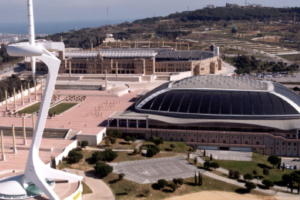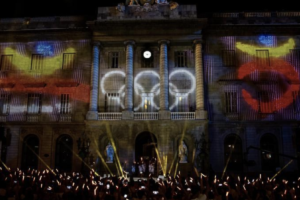30 years since the Olympic Games changed Barcelona for good

Foto: Club Natació Barcelona (Bob Martin)
Most people will agree that 1992 Olympic Games transformed the city of Barcelona.
The games brought about huge changes in the layout of Barcelona and in citizens’ thinking, and served to open up Barcelona to the world. The changes included the building of the Avenida Litoral along the coast, the ring roads, and the Olympic Village and Port.
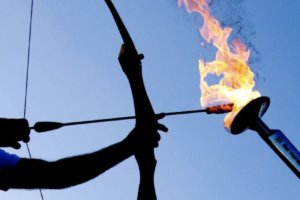
Photo: La Vanguardia (Pedro Madueño)
For the first time, the host city had the investment necessary for the construction and organization of the Olympic Games. The aim of this post is to describe how the Olympics transformed Barcelona.
Between the mountains and the sea
Since the inception of the Olympic Games in 1896, host cities have used the games to project a specific image of themselves to the world and to undertake major infrastructure projects or new urban plans.
Barcelona was no different. Barcelona is blocked in the north and south by the Besòs and Llobregat rivers and to the west by the Collserola hills, and at the time, the city had also turned its back on the sea. The coastline had been an industrial area but by the 1980s most of the factories were derelict. It was not until the Olympic Games in 1992 that the city was able to open up to the Mediterranean with the construction of the Olympic Port and the Olympic Village, designed by architectural geniuses such as Oriol Baselga.
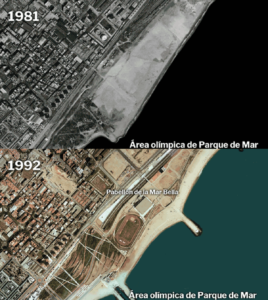
Photo: Àrea metropolitana de Barcelona, IGN
Looking back 30 years, the opening of Barcelona to the sea was not the only remarkable change. The awarding of the games to Barcelona in 1986 was the boost the city needed. The games made it possible to implement large-scale urban planning changes.
The Montjuïc district is a clear example. The iconic telecommunications tower in the Montjuïc Olympic ring, designed by architect Santiago Calatrava; the famous swimming pool, the scene of some of the most iconic pictures of Barcelona ‘92: athletes diving into the pool against the Barcelona skyline; the La Foixarda municipal rugby field; the Palau Sant Jordi and the Lluís Companys stadium are just some of the facilities that were updated or built in preparation for the Olympics. In fact, other less-well known sites such as the Segre olympic park, the Olympic canal in Castelldefels, the Granollers sports stadium, the Olympic baseball stadium in Hospitalet de Llobregat, the Olympic shooting range in Mollet del Vallés and the Olympic rowing facilities in Banyoles were all created or improved at the time.
Photo: Ajuntament de Barcelona
Apart from the sports facilities, Barcelona improved its road infrastructure with new ring roads to keep most of the traffic out of the city center. Barcelona before and after the Olympics appear to be two completely different cities, albeit with the same spirit.
Volunteer Barcelona
Many of these changes were made possible thanks to the large number of volunteers who threw themselves into the Barcelona '92 project right from the beginning. With the announcement of the candidacy, 60,000 volunteers registered to show their support for the city and make Barcelona 100% ready for the Olympics. By the end of 1986 the number of volunteer applications had risen to 102,000. Finally, after the selection process, 35,000 volunteers took part in the Olympic Games and 15,000 in the Paralympics.
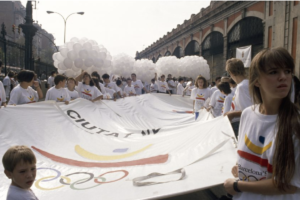
Photo: Ajuntament de Barcelona
Three decades later, the legacy of the Olympics lives on in many ways and one of them is the community of volunteers who made the event possible. Today, the Voluntaris 2000 association continues to organize and promote sporting events in various fields
The Barcelona Brand
During the years prior to the Olympic Games, Barcelona received 1.7 million tourists. After the Olympics, the number increased rapidly, reaching 2.5 million visitors in the following year. By 2019, the number had reached some 12 million.
Today, Barcelona is one of the cities with the largest number of visitors in the world. This has been made possible by the so-called “Barcelona brand” that emerged after the Games. The organization of the 1992 Olympic Games was one of the best city-branding strategies ever implemented.
During the years after the Games, Barcelona was able to project its image internationally, quickly becoming one of the most sought-after destinations for tourists. Thanks to the games, Barcelona opened up not only to the sea, but to the whole world. The Catalan capital became a more cosmopolitan city, with people coming from all over the world. Many decided to stay. The excellence of the organization of the Olympics gave Barcelona the self-esteem it needed to grow into one of the leading cities in the world.
Barcelona should continue this momentum through what could be called “Barcelona 2.0 brand.” It is in the city’s interest to revive the spirit of Barcelona'92 and position itself as an international talent hub.
Celebration of the 30th anniversary of Barcelona 1992
Thirty years on, the memory and legacy of Barcelona'92 are still very much alive. This was made clear last Thursday in the Barcelona Town Hall, when the Barcelona City Council held an institutional event to commemorate the work of volunteers and to honor the new generation of athletes. A “mapping” with lights, sound, and performances was also projected onto façade of the city hall.
Photo: La Vanguardia (Àlex García)
The event commemorating the 30th anniversary of the Olympic Games brought together many of the leading figures of the games, an event which served as a catalyst to transform Barcelona and make it one of the world’s leading cities.
If you want to know the latest news about Barcelona, its talent and its projects, subscribe to our newsletter.

